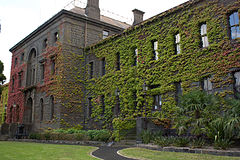Victoria Barracks, Melbourne
| Victoria Barracks | |
|---|---|
 |
|
| General information | |
| Architectural style | Renaissance Revival |
| Town or city | Melbourne |
| Country | Australia |
| Coordinates | 37°49′39″S 144°58′14″E / 37.827391°S 144.970447°ECoordinates: 37°49′39″S 144°58′14″E / 37.827391°S 144.970447°E |
| Construction started | 1856 |
| Completed | 1872 |
Located on St Kilda Road in Melbourne, Australia, Victoria Barracks Melbourne is of architectural and historical significance as one of the most impressive 19th century government buildings in Victoria, Australia.
Originally built, as accommodation for British Imperial Garrison troops, including the 12th and 40th Regiment of Foot who were involved in putting down the armed rebellion in Ballarat, Victoria, and later the Colony of Victoria's colonial forces. The Barracks housed the Department of Defence from the creation of the Commonwealth of Australia (Federation) in 1901 until 1958 when the Department of Defence moved to the new Russell Offices in Canberra. The earliest building (G Block) at Victoria Barracks were built by soldiers on the 40th Regiment, under the supervision of a Royal Engineer officer, from 1856 to 1858, while the remaining buildings were built by civil contractors with the original bluestone buildings being constructed between 1856 and 1872. A large extension (A Block New Wing) was added to accommodate HQ Department of Defence in 1917 and while it looked like the original A Block building the construction method and interior was completely modern for the time. Another modern, for the time, art deco building (M Block) was added in 1939 and the floor was the first continuous concrete pour in Australia. The Barracks were named in honour of Queen Victoria. There are also Victoria Barracks in Sydney and Brisbane.
During World War II, Victoria Barracks Melbourne housed the Australian War Cabinet. The War Cabinet comprised senior MP's from the Government and Opposition parties. The Defence Secretariat occupied the second floor of 'A Block New Wing' which also contained the office of senior military staff, the Secretary of the Department Defence (Sir Frederick Shedden), visiting Ministers of State and their secretaries and support staff, and the War Cabinet room. The wartime Prime Ministers (Robert Menzies and later John Curtin) also had offices near the War Cabinet Room throughout the War. Eric Nave's Navy cryptographic unit was at Victoria Barracks until it moved to FRUMEL.
...
Wikipedia
